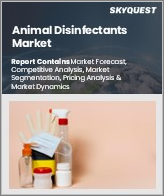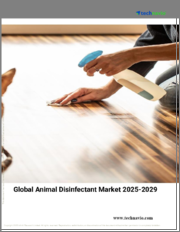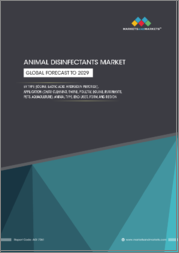
|
시장보고서
상품코드
1722382
세계의 동물용 소독제 시장 : 규모, 점유율, 성장 분석, 형태별, 유형별, 용도별, 동물 유형별, 최종 사용자별, 지역별 산업 예측(2025-2032년)Animal Disinfectants Market Size, Share, and Growth Analysis, By Form (Liquid, Powder), By Type (Iodine, Lactic Acid), By Application, By Animal Type, By End User, By Region - Industry Forecast 2025-2032 |
||||||
세계의 동물용 소독제 시장 규모는 2023년 38억 달러로 평가되었으며, 2024년 40억 7,000만 달러에서 2032년까지 71억 달러로 성장해 예측 기간 중(2025-2032년) CAGR 7.2%로 나타날 전망입니다.
Virox Technologies가 2023년 4월 플라스틱 사용량을 90% 줄인 친환경 Rescue Refill Wipe 파우치를 발매한 것이 그 예입니다. 새 인플루엔자, 살모넬라증, 브루셀라증, 결핵등의 인수 공통 감염증에 대한 의식의 고조는 병의 감염을 억제하기 위해, 수의사나 축산 환경에 있어서의 효과적인 소독의 필요성을 부조로 하고 있습니다. 세계동물보호기관이 보고한 바와 같이, 가축 및 가금 사육에서 바이오 시큐리티에는 동물용 소독제가 불가결합니다. 그 때문에 미국 농무성 동식물 검역국과 같은 조직은 확실한 소독 프로토콜을 제창하고 있어, 농가가 보다 엄격한 위생 습관을 채용함에 따라, 고품질의 소독제에 대한 수요가 증가하고 있습니다.
목차
소개
- 조사의 목적
- 조사 범위
- 정의
조사 방법
- 정보 조달
- 2차와 1차 데이터의 방법
- 시장 규모 예측
- 시장의 전제조건과 제한
주요 요약
- 세계 시장 전망
- 공급과 수요 동향 분석
- 부문별 기회 분석
시장 역학과 전망
- 시장 개요
- 시장 규모
- 시장 역학
- 성장 촉진요인과 기회
- 억제요인과 과제
- Porter's Five Forces 분석
주요 시장 인사이트
- 중요성공요인
- 경쟁도
- 주요 투자 기회
- 시장 생태계
- 시장의 매력 지수(2024년)
- PESTEL 분석
- 거시경제지표
- 밸류체인 분석
- 가격 분석
- 사례 연구
동물용 소독제 시장 규모 : 형태별 CAGR(2025-2032년)
- 시장 개요
- 액체
- 분말
동물용 소독제 시장 규모 : 유형별 CAGR(2025-2032년)
- 시장 개요
- 요오드
- 젖산
- 과산화수소
- 페놀산
- 과아세트산
- 제4급 화합물
- 염소
- 이산화염소
- 클로로헥시딘
- 글루트 쿼트 믹스
- 글리콜산
- 기타 유형
동물용 소독제 시장 규모 : 용도별 CAGR(2025-2032년)
- 시장 개요
- 유제품 소독
- 돼지
- 가금
- 말
- 반추동물
- 양식업
- 반려동물
동물용 소독제 시장 규모 : 동물 유형별 CAGR(2025-2032년)
- 시장 개요
- 가축
- 반려동물
동물용 소독제 시장 규모 : 최종 사용자별 CAGR(2025-2032년)
- 시장 개요
- 수의 클리닉
- 축산 농장
- 연구기관
- 기타 최종 사용자
동물용 소독제 시장 규모 : 지역별 CAGR(2025-2032년)
- 북미
- 미국
- 캐나다
- 유럽
- 독일
- 스페인
- 프랑스
- 영국
- 이탈리아
- 기타 유럽
- 아시아태평양
- 중국
- 인도
- 일본
- 한국
- 기타 아시아태평양
- 라틴아메리카
- 브라질
- 기타 라틴아메리카
- 중동 및 아프리카
- GCC 국가
- 남아프리카
- 기타 중동 및 아프리카
경쟁 정보
- 상위 5개사 비교
- 주요 기업의 시장 포지셔닝(2024년)
- 주요 시장 기업이 채용한 전략
- 최근 시장 동향
- 기업의 시장 점유율 분석(2024년)
- 주요 기업의 기업 프로파일
- 기업의 상세
- 제품 포트폴리오 분석
- 기업의 부문별 점유율 분석
- 수익의 전년대비 비교(2022-2024년)
주요 기업 프로파일
- Lanxess(Germany)
- Zoetis(US)
- Neogen Corporation(US)
- Ecolab(US)
- GEA Group Aktiengesellschaft(Germany)
- Virbac(France)
- Stockmeier Group(Germany)
- Veesure(India)
- Evans Vanodine International Plc(UK)
- Kemin Industries, Inc.(US)
- DeLaval(Sweden)
- Fink Tec GmbH(Germany)
- Sanosil Ltd(Switzerland)
- Virox Animal Health(Canada)
- Albert Kerbl GmbH(Germany)
- International Health Care(India)
- Sunways Bioscience LLP(India)
- Crest Aqua Tech(India)
- Advacare Pharma(US)
- Acuro Organics Ltd.(India)
결론과 권고
JHS 25.05.27Global Animal Disinfectants Market size was valued at USD 3.8 billion in 2023 and is poised to grow from USD 4.07 billion in 2024 to USD 7.1 billion by 2032, growing at a CAGR of 7.2% during the forecast period (2025-2032).
The growing emphasis on animal health is propelling the market for innovative disinfectant solutions, exemplified by Virox Technologies' launch of the eco-friendly Rescue Refill Wipe pouches in April 2023, which reduce plastic use by 90%. The heightened awareness of zoonotic diseases, such as avian influenza, salmonellosis, brucellosis, and tuberculosis, is spotlighting the necessity for effective disinfection in veterinary and farming environments to curb disease transmission. As outbreaks reported by the World Organization for Animal Health illustrate, animal disinfectants are vital for biosecurity in livestock and poultry farming. Consequently, organizations like the USDA's Animal and Plant Health Inspection Service are advocating for robust disinfection protocols, driving demand for high-quality disinfectants as farmers adopt more stringent hygiene practices.
Top-down and bottom-up approaches were used to estimate and validate the size of the Global Animal Disinfectants market and to estimate the size of various other dependent submarkets. The research methodology used to estimate the market size includes the following details: The key players in the market were identified through secondary research, and their market shares in the respective regions were determined through primary and secondary research. This entire procedure includes the study of the annual and financial reports of the top market players and extensive interviews for key insights from industry leaders such as CEOs, VPs, directors, and marketing executives. All percentage shares split, and breakdowns were determined using secondary sources and verified through Primary sources. All possible parameters that affect the markets covered in this research study have been accounted for, viewed in extensive detail, verified through primary research, and analyzed to get the final quantitative and qualitative data.
Global Animal Disinfectants Market Segments Analysis
Global Animal Disinfectants Market is segmented by Form, Type, Application, Animal Type, End User and region. Based on Form, the market is segmented into Liquid and Powder. Based on Type, the market is segmented into Iodine, Lactic Acid, Hydrogen Peroxide, Phenolic Acid, Peracetic Acid, Quaternary Compounds, Chlorine, Chlorine Dioxide, Chlorohexidine, Glut-Quat Mixes, Glycolic Acid and Other Types. Based on Application, the market is segmented into Dairy Cleaning, Swine, Poultry, Equine, Ruminants, Aquaculture and Pets. Based on Animal Type, the market is segmented into Livestock and Companion Animals. Based on End User, the market is segmented into Veterinary Clinics, Livestock Farms and Research Laboratories & Other End-Users. Based on region, the market is segmented into North America, Europe, Asia Pacific, Latin America and Middle East & Africa.
Driver of the Global Animal Disinfectants Market
The rising incidence of zoonotic diseases, including avian influenza, brucellosis, and tuberculosis, has significantly escalated the demand for efficient animal disinfectants. As livestock and poultry operations face the threat of disease outbreaks, farmers increasingly implement stringent biosecurity protocols, incorporating effective disinfectants to safeguard animal health and mitigate contamination risks. Furthermore, global regulatory organizations such as the World Organization for Animal Health (OIE) and the World Health Organization (WHO) continuously advocate for proactive disease prevention, contributing to the robust growth of the animal disinfectants market. This heightened awareness of biosecurity measures is reshaping practices within the agricultural sector.
Restraints in the Global Animal Disinfectants Market
The Global Animal Disinfectants market faces a significant restraint due to the high costs associated with innovative disinfectant products, which provide enhanced pathogen control. Small and medium-sized farmers find it challenging to invest in these advanced formulations, often made with bio-based ingredients, as their pricing tends to be elevated. This financial barrier hampers the widespread adoption of such solutions, particularly in cost-sensitive regions and developing economies, where budget limitations heavily influence purchasing choices. Consequently, the market's penetration is restricted, hindering the growth potential of animal disinfectants in these crucial segments.
Market Trends of the Global Animal Disinfectants Market
The Global Animal Disinfectants market is witnessing a significant trend towards the integration of artificial intelligence (AI) in disinfection practices, revolutionizing hygiene management in the agriculture sector. AI-driven automated systems not only optimize disinfectant usage but also provide real-time monitoring and risk assessment for pathogen control. The launch of innovative products like DeLaval Inc.'s Titan in 2024 exemplifies this trend, showcasing advanced solutions compatible with automated spray systems tailored for dairy farms. As stakeholders increasingly prioritize biosecurity and disease prevention, the demand for AI-enhanced disinfectants is expected to surge, shaping a more efficient and effective hygiene landscape in animal farming.
Table of Contents
Introduction
- Objectives of the Study
- Scope of the Report
- Definitions
Research Methodology
- Information Procurement
- Secondary & Primary Data Methods
- Market Size Estimation
- Market Assumptions & Limitations
Executive Summary
- Global Market Outlook
- Supply & Demand Trend Analysis
- Segmental Opportunity Analysis
Market Dynamics & Outlook
- Market Overview
- Market Size
- Market Dynamics
- Drivers & Opportunities
- Restraints & Challenges
- Porters Analysis
- Competitive rivalry
- Threat of substitute
- Bargaining power of buyers
- Threat of new entrants
- Bargaining power of suppliers
Key Market Insights
- Key Success Factors
- Degree of Competition
- Top Investment Pockets
- Market Ecosystem
- Market Attractiveness Index, 2024
- PESTEL Analysis
- Macro-Economic Indicators
- Value Chain Analysis
- Pricing Analysis
- Case Studies
Global Animal Disinfectants Market Size by Form & CAGR (2025-2032)
- Market Overview
- Liquid
- Powder
Global Animal Disinfectants Market Size by Type & CAGR (2025-2032)
- Market Overview
- Iodine
- Lactic Acid
- Hydrogen Peroxide
- Phenolic Acid
- Peracetic Acid
- Quaternary Compounds
- Chlorine
- Chlorine Dioxide
- Chlorohexidine
- Glut-Quat Mixes
- Glycolic Acid
- Other Types
Global Animal Disinfectants Market Size by Application & CAGR (2025-2032)
- Market Overview
- Dairy Cleaning
- Swine
- Poultry
- Equine
- Ruminants
- Aquaculture
- Pets
Global Animal Disinfectants Market Size by Animal Type & CAGR (2025-2032)
- Market Overview
- Livestock
- Companion Animals
Global Animal Disinfectants Market Size by End User & CAGR (2025-2032)
- Market Overview
- Veterinary Clinics
- Livestock Farms
- Research Laboratories & Other End-Users
Global Animal Disinfectants Market Size & CAGR (2025-2032)
- North America (Form, Type, Application, Animal Type, End User)
- US
- Canada
- Europe (Form, Type, Application, Animal Type, End User)
- Germany
- Spain
- France
- UK
- Italy
- Rest of Europe
- Asia Pacific (Form, Type, Application, Animal Type, End User)
- China
- India
- Japan
- South Korea
- Rest of Asia-Pacific
- Latin America (Form, Type, Application, Animal Type, End User)
- Brazil
- Rest of Latin America
- Middle East & Africa (Form, Type, Application, Animal Type, End User)
- GCC Countries
- South Africa
- Rest of Middle East & Africa
Competitive Intelligence
- Top 5 Player Comparison
- Market Positioning of Key Players, 2024
- Strategies Adopted by Key Market Players
- Recent Developments in the Market
- Company Market Share Analysis, 2024
- Company Profiles of All Key Players
- Company Details
- Product Portfolio Analysis
- Company's Segmental Share Analysis
- Revenue Y-O-Y Comparison (2022-2024)
Key Company Profiles
- Lanxess (Germany)
- Company Overview
- Business Segment Overview
- Financial Updates
- Key Developments
- Zoetis (US)
- Company Overview
- Business Segment Overview
- Financial Updates
- Key Developments
- Neogen Corporation (US)
- Company Overview
- Business Segment Overview
- Financial Updates
- Key Developments
- Ecolab (US)
- Company Overview
- Business Segment Overview
- Financial Updates
- Key Developments
- GEA Group Aktiengesellschaft (Germany)
- Company Overview
- Business Segment Overview
- Financial Updates
- Key Developments
- Virbac (France)
- Company Overview
- Business Segment Overview
- Financial Updates
- Key Developments
- Stockmeier Group (Germany)
- Company Overview
- Business Segment Overview
- Financial Updates
- Key Developments
- Veesure (India)
- Company Overview
- Business Segment Overview
- Financial Updates
- Key Developments
- Evans Vanodine International Plc (UK)
- Company Overview
- Business Segment Overview
- Financial Updates
- Key Developments
- Kemin Industries, Inc. (US)
- Company Overview
- Business Segment Overview
- Financial Updates
- Key Developments
- DeLaval (Sweden)
- Company Overview
- Business Segment Overview
- Financial Updates
- Key Developments
- Fink Tec GmbH (Germany)
- Company Overview
- Business Segment Overview
- Financial Updates
- Key Developments
- Sanosil Ltd (Switzerland)
- Company Overview
- Business Segment Overview
- Financial Updates
- Key Developments
- Virox Animal Health (Canada)
- Company Overview
- Business Segment Overview
- Financial Updates
- Key Developments
- Albert Kerbl GmbH (Germany)
- Company Overview
- Business Segment Overview
- Financial Updates
- Key Developments
- International Health Care (India)
- Company Overview
- Business Segment Overview
- Financial Updates
- Key Developments
- Sunways Bioscience LLP (India)
- Company Overview
- Business Segment Overview
- Financial Updates
- Key Developments
- Crest Aqua Tech (India)
- Company Overview
- Business Segment Overview
- Financial Updates
- Key Developments
- Advacare Pharma (US)
- Company Overview
- Business Segment Overview
- Financial Updates
- Key Developments
- Acuro Organics Ltd. (India)
- Company Overview
- Business Segment Overview
- Financial Updates
- Key Developments


















